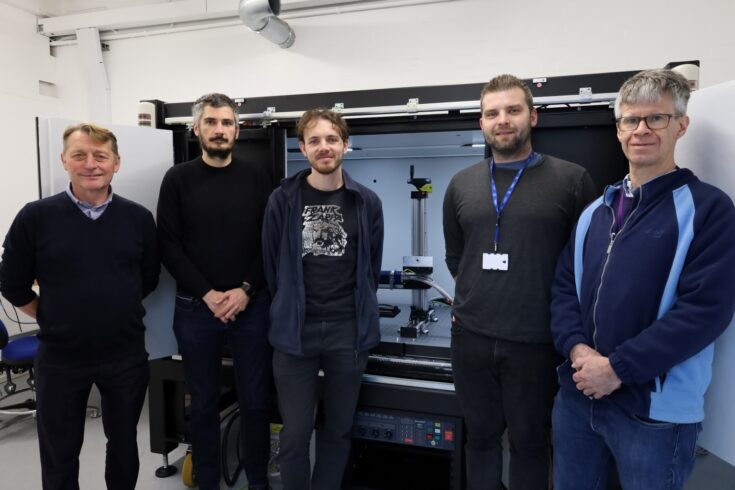A new X-ray irradiation facility has been created that can assess the damage caused by ionising radiation in detector systems – giving scientists and researchers the chance to understand the damage mechanism in detectors and to prolong the life of these vital components of scientific experiments.
Based at the Science and Technology Facilities Council’s (STFC) Daresbury Laboratory, the X-ray generator, deployed in the irradiation facility, is the first of its kind at the site since the Synchrotron Radiation Source closed in 2008.
What are particle detectors?
Particle accelerators are probably one of the most well-known scientific instruments. They accelerate particles such as protons, heavy nuclei or electrons at amazing speeds to probe matter at microscopic level. They do so either by directly crashing together bunches of protons or heavy nuclei, or by producing flashes of X-rays, generated from the vibrations of electron beams, that are shined onto specimens.
As the name suggests, detectors ‘detect’ or ‘photograph’ the products of these interactions and help scientists to understand natural processes on tiny dimensional and temporal scales.
Radiation damage to detectors
Detectors are made up of sensors of various materials. At Daresbury Laboratory, the scientists and engineers have particular expertise with detectors using cryogenic high purity germanium (HPGe) sensors for the detection of X-rays, and monolithic complementary metal oxide semiconductor (CMOS) sensors for the measurement of the trajectories of charged particles produced by the collision of protons and heavy nuclei. These sensors have different uses, but they do have one thing in common: radiation is the major cause of performance degradation for both.
If detectors and the sensors within them get damaged over time, it can have serious effects on the results they are able to pull from the accelerators.
Detecting detector damage
STFC’s new X-ray irradiation facility will enable in-house studies of the effects of ionising radiation, meaning radiation affecting the electronic structure of sensor materials, like that produced by accelerators. The substantial size of the radiologically shielded chamber housing the X-ray generator means that both room temperature (for example, CMOS sensors) and bulkier cryogenic technologies (for example, HPGe sensors) can be irradiated and then studied.
This increases the competitiveness and efficiency of the team at Daresbury to complete tests and to deliver results to collaborators in shorter time scales. As well as having ‘unlimited’ access to an in house-facility to perform higher complexity irradiation tests. The benefit of this approach is the reduction of the design-test-operation cycle for future detector development.
Testing with CERN
A set of silicon diodes was recently taken to CERN to be calibrated with the CERN X-ray generator, a reference X-ray system for the scientific community in which the team at Daresbury operates. The silicon diodes were then brought back to Daresbury Laboratory and used again in the new X-ray facility to measure in a systematic way the rate of irradiation of the X-ray generator. This is a known way of calibrating the X-ray generator for radiation damage. The great news is that the Daresbury X-ray irradiation facility is now ready to be used.

Marcello Borri from STFC Daresbury Laboratory stood in a lab space in front of the new X-ray irradiation facility. Credit: STFC
Marcello Borri, Group Leader of the Detectors Systems Group at STFC Daresbury Laboratory has been instrumental in bringing this facility to fruition.
He says:
My team and I were interested in expanding our capabilities and expertise to study the effects produced by ionising radiation on sensors and electronics. In fact, the damage produced by ionising radiation is the dominant effect responsible for the ageing of our detectors.
Therefore, we proactively applied to the funding application called “Support early technology development of basic technologies” from UKRI. The successful outcome of our application enabled us to turn an ambition into a reality. We are now fully engaged in exploiting the facility for our research and to make it accessible to the wider community.
Welcoming the first users
The first use will be on the Electron Ion Collider (EIC) project. The EIC is a future experimental facility, which will be built in the US in the next decade. Currently, the project is in the research and development phase, and the collaboration is optimising the design of CMOS sensors for the experimental setup. As part of this, the team at Daresbury is tasked to characterise (and irradiate) high-speed data-transmission circuits in collaboration with STFC’s Rutherford Appleton Laboratory and the University of Birmingham.
In parallel, the team is learning how to use the facility to irradiate in-house HPGe sensors. This has direct applications to the HPGe detectors system (called XH) developed by the Daresbury team and currently deployed at the European Synchrotron Radiation Facility in Grenoble, France.
Industry use
It’s not just detector technology for accelerator-based applications which can be tested in the X-ray irradiation facility.
Off-the-shelf electronic integrated circuits for a number of scientific uses could be validated using the facility – positioning Daresbury Laboratory as a centre to foster high-tech innovation and a knowledge-based economy at a regional and national scale.
Interestingly, the X-ray irradiation facility could also be used for space technology, where it is often vital to understand the radiation effects on electronics such as satellite systems during the development of instruments. Daresbury Laboratory is home to the North West Space Cluster, and a local X-ray irradiation facility is a beneficial asset for the development of a network of high-tech entrepreneurs targeting space applications.
Alexandra Bromhead, STFC Business Development Manager, is excited about the potential for the facility.
She says:
There are a range of commercial applications that we started to explore for this facility, including radiation damage testing, integrated circuit research and development for space, sensor testing and product acceptance tests for radiation environments.
Expression of interests have been received from potential commercial users and discussions are ongoing.



